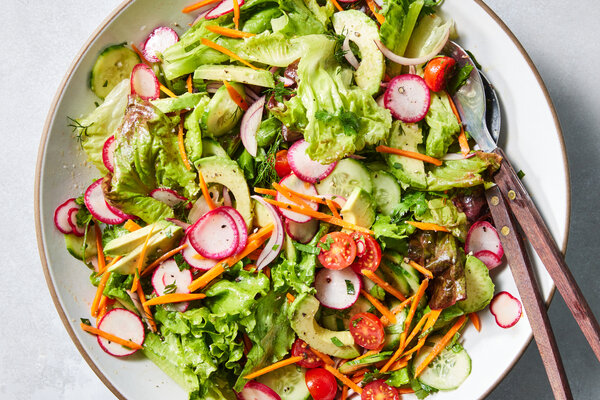Proper asparagus-eating etiquette has long been a subject of debate: Should you cut the treelike spears with a fork and knife, or are they an acceptable finger food?
When it comes to asparagus’s nutritional value, though, there’s little dispute. Here are its most notable health attributes, plus fresh ways to prepare it from New York Times Cooking.
It’s rich in prebiotics.
Asparagus contains a type of prebiotic fiber called inulin, said Elizabeth Klingbeil, a dietitian and assistant professor at the University of Texas at Austin. Your stomach can’t break down inulin, she said, so it passes into your intestines undigested. Once there, the inulin helps nourish the good bacteria that make up your gut microbiome.
When these good bacteria feed off the inulin in asparagus and other fiber-rich foods, they produce compounds that play a role in preventing inflammation in your intestines, Dr. Klingbeil said. Over time, excess inflammation can increase your risk of chronic gastrointestinal diseases, including inflammatory bowel disease and colon cancer.
Nourishing gut bacteria with prebiotic fiber may have benefits beyond your digestive system, said Douglas Moellering, an associate professor of nutrition sciences at the University of Alabama at Birmingham. Early research suggests a healthy gut microbiome could improve your brain function, stress levels and mood through a complex network called the gut-brain axis.
It could help protect your eyesight.
Asparagus is a good source of two antioxidants called lutein and zeaxanthin, which help support the part of your eye’s retina called the macula.
A healthy macula helps you see sharp details and colors directly in front of you, said Richard van Breemen, a professor of pharmaceutical sciences at Oregon State University. When the cells in your macula break down, which can happen as you age, your vision can begin to blur. This condition, called age-related macular degeneration, affects nearly 13 percent of Americans 40 and over. (In severe cases, you can lose your eyesight entirely.) And while eating lutein and zeaxanthin-rich foods won’t stave off eye disease altogether, Dr. van Breemen said it may help.
It’s a good source of vitamin K.
Six spears of asparagus contain around 40 micrograms of vitamin K — a respectable start to the 90 to 120 micrograms recommended daily. When you cut yourself, certain proteins help your blood coagulate to stop the bleeding, said Vanessa da Silva, a dietitian and diabetes educator at Sarver Heart Center at the University of Arizona. These proteins, called clotting factors, need vitamin K to function.
Is there a ‘healthiest’ way to prepare asparagus?
Asparagus is a nutritious addition to your diet regardless of how you prepare it, said Nancy E. Moran, an associate professor of pediatrics in the nutrition division at Baylor College of Medicine.
But if you want to maximize the bioavailability of asparagus’s vitamins and minerals (in other words, how easily your body can access them), Dr. Klingbeil said it’s best to steam or roast the spears.
The chemical structures that make up asparagus’s nutrients are “folded up tightly,” she said. Heat from cooking can loosen up these folds so your body can readily use the compounds. Experts don’t typically recommend boiling asparagus, since some vitamins can leach out into the water.
You might occasionally find purple or white asparagus beside the green stalks at the market. The colors reflect a slightly different makeup of antioxidants, but experts agree they’re all comparably nutritious.
And by the way: “There’s nothing wrong with you” if you notice your urine has an unpleasant odor after you eat asparagus, Dr. da Silva said. Certain compounds in asparagus contain the chemical sulfur, which is known for its pungent scent. When your body breaks down these compounds, some of that sulfur can end up in your urine.
As for the etiquette debate, Dr. Moran said she likes to cut her asparagus with a fork and knife — but casts no judgment on picker-uppers.
“The important thing is that you’re eating your vegetables,” she said.
Asparagus is the star in this silky spring-green soup, complemented by earthy spinach and herbs and sweet fennel and leeks.
Recipe: Asparagus, Spinach and Leek Soup
Slicing asparagus at an angle ensures it isn’t stringy. For a tender-crisp texture, cook it for just a minute or two less than the soy-slicked shrimp.
Recipe: Quick Shrimp and Asparagus Stir-Fry
Yes, you can eat asparagus raw. Using a vegetable peeler to shave thick stalks into ribbons gives the vegetable a delicate crispness, welcome over chewy grains and mushrooms.
Recipe: Asparagus Mushroom Grain Bowl










